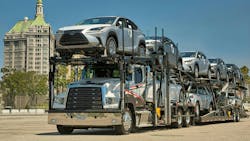Pandemic-driven supply chain issues are resolving after years of truck inventory challenges; new equipment availability is recovering. The near future of rental and leasing operations looks good.
With rising technologies and tightening regulations, 2025 will be a strong year as emissions requirements herald a 2027 prebuy.
“The leasing and rental market was strong in 2022 and 2023 and is anticipated to have another good year in 2024, although with a return to a more typical market environment,” Dane Mercier, director of franchise operations for PacLease, told FleetOwner. “However, in 2025, the anticipation of a prebuy ahead of the 2027 emissions is likely to fuel a strong year.”
The emissions regulations prebuy and continued technological improvements are increasing demand for renting and leasing new vehicles. Meanwhile, the prebuy and ongoing freight recession limits how many fleets can actually rent or lease.
Freight recession limits leasing
The ongoing freight recession limits how many for-hire fleets can rent or lease. Fleets face continued year-over-year freight rate declines, volume decreases, and rising operational costs.
“As you think about volumes being down, rates being down, and reduced revenues, it impacts their financial metrics and their financial stability,” Hadley Benton, VP of business development for Fleet Advantage, told FleetOwner. “It makes credit a lot tighter for them.
“On the flip side of that, you also have the financial side of the business. From a banking standpoint, they’ve really kind of gone on a diet for the last year or so. And so they’re being a lot stingier and a lot more particular with credit review.”
This relatively hostile business environment makes it difficult for fleets to make payments reliably.
“Lessors face additional risk due to potential default,” Benton told FleetOwner. “Any of the lessors in the business have to be a lot more careful about who they’re leasing to, just to make sure they don’t increase their exposure to riskier credit out there.”
See also: FMCSA seeking information on fairness of leasing agreements
Private fleets, however, operate in a less hostile environment than for-hire fleets, and so rental and leasing options for these fleets are not as limited.
“Many leasing and rental customers are traditionally private fleets and not necessarily tied to the cyclicality of the general freight environment,” Mercier explained.
Interest in pilots for EVs and AVs
Alternative fuel and autonomous vehicle technologies are on the rise. Fleets interested in these rising technologies can find a promising opportunity through renting or leasing: pilots.
“In this phase of the evolution to alternative fuels, companies are looking to do pilots,” Benton told FleetOwner. “As opposed to just jumping in with both feet, they want to test certain different types of equipment and alternative fuels in different markets—and so leasing and renting becomes more attractive.”
According to Mercier, leasing and renting can help reduce costs associated with fleet electrification, such as maintenance and charging support.
“We continue to see interest from our customer base to either lease or rent electric vehicles,” Mercier said. “Many of them are just starting to familiarize themselves with these products, and by utilizing a lease or rental platform, they can reduce many of the potential concerns.”
The 2027 prebuy
Beginning with the 2027 model year, trucks must comply with some of the most stringent emissions regulations yet.
“As the regulations change and become more strict, there’s new equipment out there that fleets are going to be encouraged, let’s say, to adopt,” Benton explained.
The California Air Resources Board’s NOx reduction policies and U.S. Environmental Protection Agency’s final Phase 3 greenhouse gas emissions standards will push tractor manufacturers to implement stronger aftertreatment systems and more efficient engine designs.
Greater costs
Even though these cleaner tractors are achievable, their price will be significantly higher than that of previous models.
“To comply with the 2027 emissions regulations, additional technology and components will be added to the units, which may have an effect on the price and maintenance,” Mercier said.
Industry experts project significant cost increases for both the acquisition and maintenance of these cleaner vehicles.
“The expectation is that equipment will cost anywhere from $25,000 to $30,000 more in ‘27 than it does today,” Benton said.
Plan ahead for the prebuy
This impending spike in the cost of equipment acquisition is pushing many fleets to secure trucks that comply with current regulations.
“We anticipate a possible prebuy starting some time in 2025 and running through 2026,” Mercier said.
This prebuy approach may strain supply for new vehicles leading up to 2027.
“Companies are going to look to pull back a lot of those replacements and avoid ’27,” Benton said. “What that’s going to do is potentially create another situation where we’re on allocation.”
As businesses rush to buy new equipment before the new emissions standards, manufacturers may not be able to produce enough trucks to meet demand. This means that leasing and rental companies, too, may not have enough vehicles to satisfy customer demand.
“There’s actually an expectation that 2026 is going to be sold out probably as early as the first quarter of ’26,” Benton said.
This is the second part of a two-part series about truck leasing and rental trends. Read part one here.
About the Author
Jeremy Wolfe
Editor
Editor Jeremy Wolfe joined the FleetOwner team in February 2024. He graduated from the University of Wisconsin-Stevens Point with majors in English and Philosophy. He previously served as Editor for Endeavor Business Media's Water Group publications.

